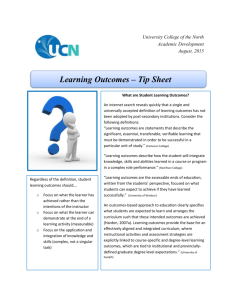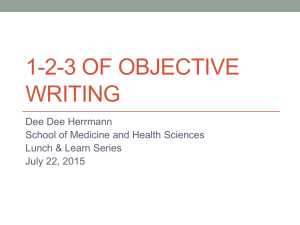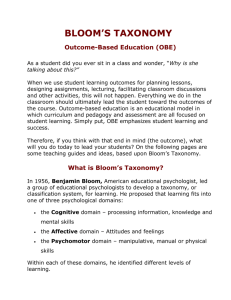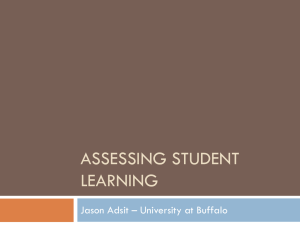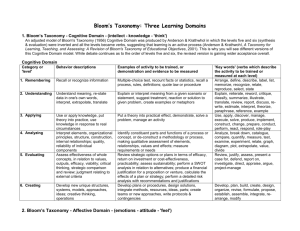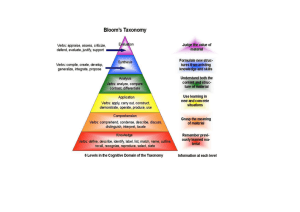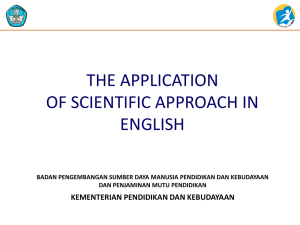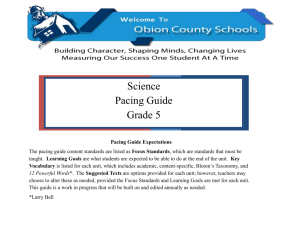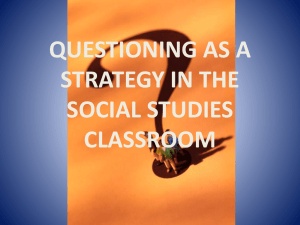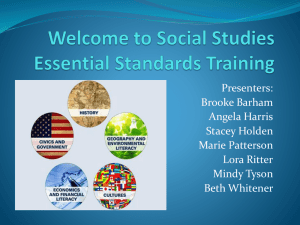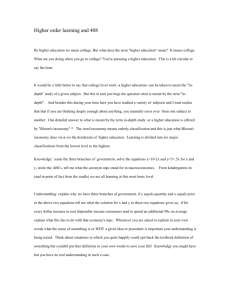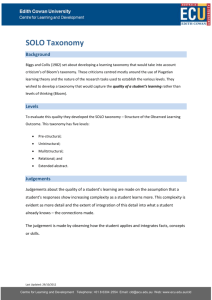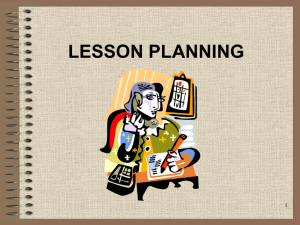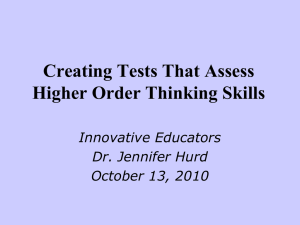SLO 1 What are LO? Why LO?
advertisement
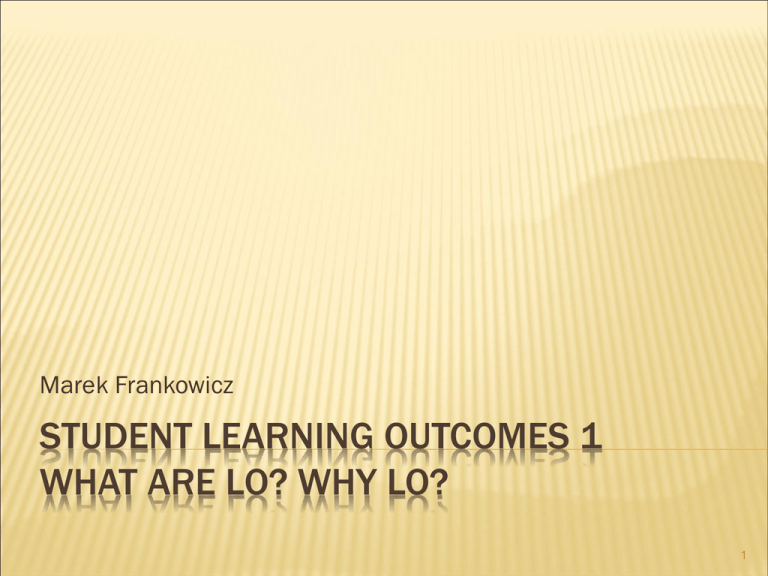
Marek Frankowicz STUDENT LEARNING OUTCOMES 1 WHAT ARE LO? WHY LO? 1 INITIAL REMARK Definition of an expert (O. Wilde): „Ordinary man, away from home, giving advice” Some experts propose answers for which there are no questions … or teach & preach useless things I would like to be useful; please help me 2 CONTEXTS Globalization Change From Stone Age to Conceptual Age European Higher Education Area, TUNING, TEMPUS etc. 3 NO MAN IS AN ISLAND, ENTIRE OF ITSELF. EACH IS A PIECE OF THE CONTINENT, A PART OF THE MAIN… John Donne 4 THERE ARE MANY DEFINITIONS OF LO Good working definition (ECTS Users’ Guide): Learning outcomes are statements of what a learner is expected to know, understand and/or be able to demonstrate after completion of a process of learning. Learning outcomes focus on what the learner has achieved rather than the intentions of the teacher. Learning outcomes focus on what the learner can demonstrate at the end of learning activity 5 AIMS, OBJECTIVES AND ALL THAT JAZZ… Aims – broad purposes or goals e.g. this course aims to…They are generally aspirational at programme level but are more specific and achievable at the level of modules/courses. Objectives – the specific steps that take us from where we are now towards our goals. They can be formulated as teaching objectives (what the teacher does to promote students’ learning), as curriculum objectives (how the curriculum supports the achievement of the intended learning) and as objectives for students’ learning (what the students do to learn). Intended learning outcomes – what students will know and be able to do as a result of engaging in the learning process. They represent statements of achievement expressed from the learners’ perspective…at the end of the course learners will know … and be able to do…. Course/module learning outcomes must be achievable and measurable. They should connect directly to the assessment criteria that are used to judge achievement. 6 WHY WRITE LO? A focus on student learning Clarity Overal vision and progression Realism Clear connection between goals, teaching and assessment The process of educational development in the academy Better quality assurance 7 TWO KEY COMPETENCES FOR THE 21ST CENTURY Ability to Learn Ability to Adapt Along with „Lifelong Learning” (LLL) concept we shall also promote „Lifelong Mobility” (LLM) (EURASHE WG „Mobility & International Openness”) Prerequisites for successful LLL and LLM: Clear and precise information on educational offer Efficient recognition mechanisms (based on evidence) Learning Outcomes! 8 LO AND EMPLOYABILITY „Employability is the Art of Converting Learning Outcomes into Earning Incomes” (M.F.) Short version: From Learning to Earning 9 TAXONOMY OF LO TAXONOMIES Bloom’s Taxonomy SOLO (Structure of Observed Learning Outcomes) Taxonomy Fink’s Taxonomy …. Niemierko Taxonomy …. Bloom’s Taxonomy: Cognitive Domain Affective Domain Psychomotor Domain 10 BLOOM’S TAXONOMY: COGNITIVE DOMAIN Bloom 1. Knowledge 2. Comprehension 3. Application 4. Analysis 5. Synthesis 6. Evaluation Anderson et al. 1. Remember 2. Understand 3. Apply 4. Analyse 5. Evaluate 6. Create 11 BLOOM’S TAXONOMY: AFFECTIVE DOMAIN 1. 2. 3. 4. 5. Receiving Responding Valuing Organisation & Conceptualisation Characterisation by Value 12 BLOOM’S TAXONOMY: PSYCHOMOTOR DOMAIN Bloom 1. Imitation 2. Manipulation 3. Precision 4. Articulation 5. Naturalisation Dave, Ferris & Aziz 1. Perception/Observing 2. Guided Response/ Imitation 3. Mechanism 4. Complex Response 5. Adaptation 6. Origination 13 WRITING LO: ACTION WORDS Examples: Knowledge → define, describe, list Comprehension → classify, explain, illustrate Application → apply, prepare, use Analysis → analyse, deduce, compare Synthesis → design, explain, formulate Evaluation → assess, criticise, justify 14 EXAMPLES OF LO List the criteria to be taken into account when caring for a patient with tuberculosis Classify reactions as exothermic and endothermic Relate energy changes to bond breaking and formation Compare classical and quantum harmonic oscillator Organise a patient education programme Discuss the role of Internet in physics teaching Design a poster presentation Examine a patient Use MS Office effectively and skilfully Display a willingness to communicate well with patients Resolve conflicting issues between personal beliefs and ethical considerations 15 FROM WIKIPEDIA: During the Gupta period in India (AD 300–600), craftmen's associations, which may have had archaic antecedents, were known as shreni. Greek organizations in Ptolemaic Egypt were called koinon, starting from their 3rd century BC origins of Roman collegia, spread with the extension of the Empire. The Chinese hanghui probably existed already during the Han Dynasty (206 BC - AD 220):, but certainly they were present in the Sui Dynasty (589 - 618 AD). 16 17 LO AT THE PROGRAM LEVEL Describe what the learner can accomplish as a result of completing a program They should be aligned with the institution’s mission They should focus on broad conceptual knowledge and higher order skills They represent the minimum requirements to complete a program 18 LO AT THE MODULE LEVEL Describe what the learner can accomplish as a result of completing a module They should be aligned with the program LO They represent the minimum requirements to complete a module 19 DESIGN OF STUDY PROGRAM – TUNING APPROACH 1. 2. 3. 4. 5. 6. 7. 8. 9. 10. Determine need and potential Define the profile and the key competences Formulate programme LO Decide whether modularise or not Identify competences and LO for each module/course unit Determine the approaches to teaching, learning and assessment Check whether the key generic and subject specific competences are covered Describe the programme and the course units Check balance and feasibility Implement, monitor and improve 20 TEN STEPS TOWARDS LO (NSHU 2006) WRITE Step 1. Formulate: What? Subject-related content in LO Step 2. Formulate: How? The format of LO (active verbs etc.) REVISE Step 3. Focus distinguish between LO and other descriptions Step 4. Specify make LO observable and clear Step 5. Refine distinguish between learning activities and results Step 6. Clarify vague outcomes Step 7. Limit the number of LO CHECK Step 8. Adjust check that LO can be assessed Step 9. Estimate student learning time Step 10. Calibrate check the module in relation to other modules 21 FROM WISHFUL THINKING TO FINAL RESULTS Program aims and objectives Intended learning outcomes Curriculum Evaluation of students Achieved learning outcomes 22


